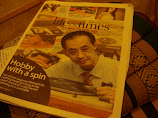Thanks Joe !
* Joe's other upgrade projects:
1. A mid-winter RP1 upgrade project in Chicago


Disclaimer :
I am not affiliated, associated with any turntable manufacturers or their agents. If in the course of my work, certain company, brand, trademark or their products are mentioned or referred to, is considered nominative use, and does not in any way imply any relationship and/or endorsement with the corresponding trademark owners, their products or brands.
Michael,
I have been enjoying my turntable since installing your top and bottom brace. The sound is more solid and focused than before. I have also noticed the sound being less mechanical which I attribute to a reduction of vibrations. The soundstage is deeper and wider. Certainly a lot of improvement for the low cost of the braces. The first vinyl I listened to was a 45rpm recording of Adagio d’Albinoni with double-bass and organ. The double-bass was focused and not blurry as it was before the braces. The organ was now further back and filled the whole rear wall of my room. I was amazed at the difference. Next I listened to a record of Cleo Laine performing live at Carnegie Hall. I had never heard hall ambiance that clearly on my system and Cleo sounded much more flesh and blood then ever before. Every record I have listened to has benefitted in much the same way. I had only recently learned of your products and I am pleased you created your braces. My 14 year old Rega Planar 2 is sounding better than I expected. It had been tweaked before but the braces are a very nice step up. Thank you, JohnMichael |
Hello Michael,
Sorry for not getting back to you with my impressions of your upgrades,I have been too busy playing records and swapping other components and upgrades in and out of my system. The first thing I noticed was the bass, so much tighter and more pronounced although never overbearing, in fact very addictive {I've never owned a sub woofer}. Next was the stability of sustained notes, I kept listening for that familiar wobble but its finally gone. GT reference sub platter and Rega white belt didn't fix it but your pulley and silicon belts did. Changes to upper frequencies initially appeared to be of a rolled off nature until I realised that it was the lack of smearing that creates this perception, the whole reason I got a GT acrylic platter was because the glass appeared to cause ringing and harsh high frequencies but now the glass is back and I'm using it without the felt mat! This sounded dreadful before but now sounds the best. These changes are the result of all the upgrades as I did not test them one at a time. I am very interested in what your isolation platform would do as well. Thank you Ross Bull |
Drilling through the plinth and using the other spacer underneath:
The more focused sound now has me wanting to hear a RB700 with its stainless steel base. I am astonished at the improvement gained from aluminium discs being added to the feet of my Rega. The sound is noticeably more focused and nuanced. |
Finally had the time to install the upgrades for my Rega P3, aluminum sub-platter; aluminum legs, and silicone belt. Two important things I wanted to share with you and your followers: a) indeed very easy to install, I had my doubts due to the fact that I am not that technically savvy but if I can do it, anybody can; and b) indeed a sonic improvement, tighter bass, and a noticed a welcomed gain that translated into a better soundstage, this with my favorite drum recording of Morello and Take Five. Now thinking of upgrade 2. Thanks again, and all the best. Attached a couple of pictures of my Rega P3 with updates. Mexico City |
Here are the pics as promised!! Sounds great!! By the way I put washers under the original rega rubber feet to give the brace something besides rubber to tighten down with. Also I had to move the double pulley up a bit to accommodate the brace. Here are all my mods: Origin live silver tonearm Groovetracer Delrin platter Isosub gt sub platter Lim double pulley Lim silicon bands Lim top and bottom braces Lim extra big bearing nut Groovemat Rega 24v dc motor External TT psu Now this 400 usd table sounds like a 4000 usd table. Awesome. Thanks, feel free to post. Daniel, New York, USA |

 Enjoy life with LP's and Turntables designed and coded by EZwpthemes | Bloggerized by FalconHive.
Enjoy life with LP's and Turntables designed and coded by EZwpthemes | Bloggerized by FalconHive.